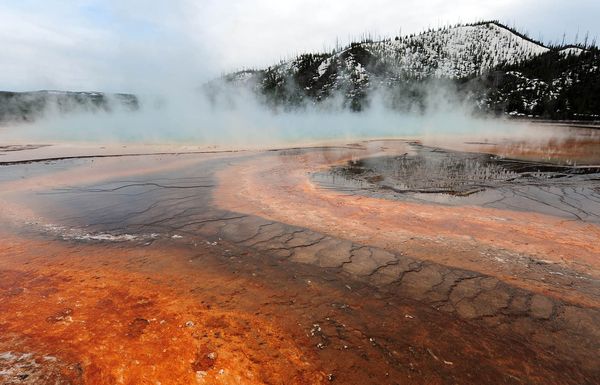
"We found it to be about two-and-a-half times larger than we thought," said analysis team scientist James Farrell of the University of Utah in Salt Lake City. "That's not to say it's getting any bigger. It's just that our ability to see it is getting better."
The size finding, presented at the American Geophysical Union fall meeting in San Francisco last Thursday, has big implications for the extent of the volcano's impact when it next erupts.
The supervolcano underneath the national park last erupted on a massive scale some 640,000 years ago, according to the U.S. Geological Survey (USGS). It is a potential supervolcano, capable of spewing more than 240 cubic miles (1,000 cubic kilometers) of magma across Montana, Idaho, and Wyoming, with global climate effects.
"We believe it will erupt again someday, but we have no idea when," Farrell said.
More Magma Measured
In the new analysis, Farrell and his team calculated the size of the volcano's magma reservoir by analyzing earthquake measurement data collected from 1984 to 2011 from about 40 seismometers installed around Yellowstone.
Yellowstone National Park is located in a very seismically active region and experiences between 1,500 to 2,000 earthquakes a year. Most of the temblors are too small to be felt by humans, but occasionally "you will have a large earthquake like the magnitude 7.3 one that we saw in 1959," Farrell said.
The team used software to calculate how long it takes for the seismic waves to travel from the epicenter of an earthquake to the surface seismometers. They next analyzed the data to find regions where the seismic waves appeared to slow down, which is a sign that the waves were traveling through magma.
"Seismic waves travel slower through molten material," Farrell said.
The team used that information to create a map of the underground magma reservoir beneath Yellowstone. Farrell likened his team's technique to the medical scanners doctors use to image inside the human body. "It's the exact same technique. It's just that we use seismic waves, and we do it on a much bigger scale," he said.
The team's map revealed that Yellowstone's magma reservoir is not arranged vertically, as once thought, but rather it is tilted in a northwest to southeast direction. It's also much bigger than previously thought, measuring about 55 miles by 20 miles (90 by 30 kilometers) on each side and about 6 miles (10 kilometers) deep.
The new size estimate means the current magma reservoir is roughly equal to what it was when the supervolcano last erupted, about 640,000 years ago.
"What we're seeing now agrees with the geologic data that we have about past eruptions," Farrell said. "And that means there's the potential for the same type of eruption that we've seen in the past."
Scientists think that after each eruption, the magma reservoir is emptied, and it takes a long time for it to refill again.
Global Catastrophe
Scientists predict that when the Yellowstone supervolcano does erupt, it will have global consequences. Large amounts of ash and pulverized rock from the eruption will get lofted into the atmosphere and then fall back slowly to Earth.
"You'll get ashfall as far away as the Great Plains, and even farther east," Farrell said.
Furthermore, volcanic material and gases that linger in the atmosphere will block sunlight, resulting in a global temperature decrease.
There will be nothing humans can do to prevent the eruption from happening, Farrell said, but at least with the instruments in place there should be ample warning before the volcano erupts. The Yellowstone Volcano Observatory partnership of state, federal, and academic experts regularly monitors the volcano.
"I think we'll have anywhere from weeks to months of warning that magma is moving up into the shallow crust and [that] something is going on," Farrell said.
As catastrophic as an eruption of the Yellowstone supervolcano would be, Farrell said it's not an imminent threat, nor the one people should be focusing on. The USGS puts the annual odds of a super-eruption at 1 in 730,00.
"The most likely hazard in Yellowstone is from large earthquakes," he said. "A lot of people say that the Yellowstone volcano is overdue to erupt, but there's no evidence that it is overdue. We can't say when the next eruption is going to happen."



Reader Comments
to our Newsletter